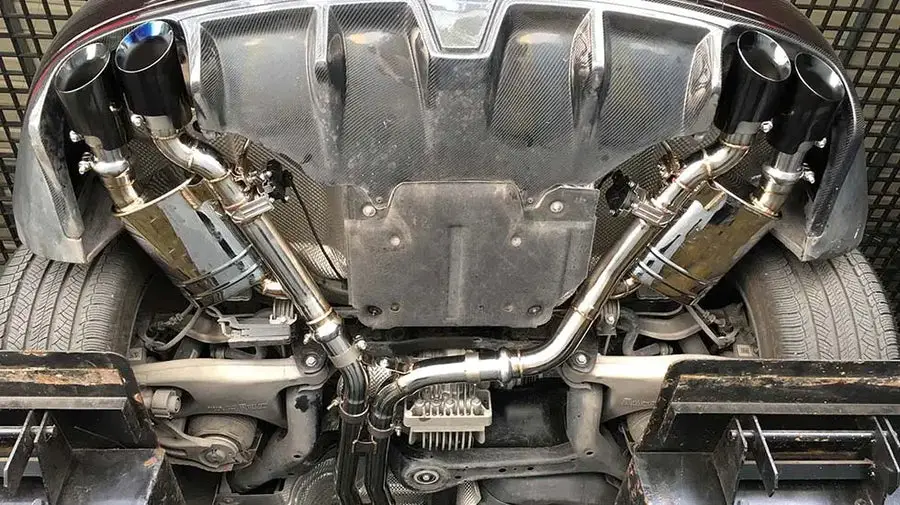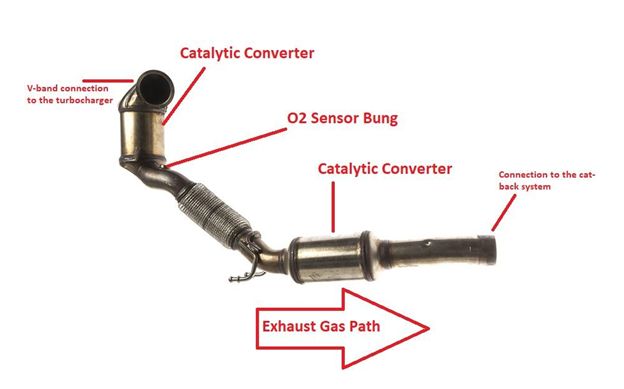What is a downpipe on an exhaust system: A downpipe connects the turbocharger to the rest of the exhaust system, improving exhaust flow and reducing turbo lag, which boosts engine performance.
The downpipe is an essential component of an exhaust system, playing a crucial role in enhancing vehicle performance. It is located after the turbocharger or catalytic converter and serves to direct exhaust gases away from the engine. In this article, we will dive deep into the importance of the downpipe, how it works, and why upgrading or replacing it can improve your car’s performance.

Contents
Role of the Downpipe in an Exhaust System
The exhaust system in a car is responsible for managing and directing exhaust gases out of the engine. The downpipe, in particular, is the part of the exhaust system that connects the turbocharger or exhaust manifold to the rest of the exhaust components. It is a pipe that channels the gases produced by the engine and directs them into the rest of the exhaust system, where they are eventually expelled from the vehicle.
In turbocharged engines, the downpipe plays an especially important role. After the exhaust gases pass through the turbocharger, the downpipe helps to direct them towards the catalytic converter and muffler, allowing the exhaust system to effectively process and expel the gases. A well-designed downpipe can help improve engine performance, fuel efficiency, and turbo response.
Why the Downpipe Matters in the Exhaust System
The downpipe’s importance can be understood by looking at its direct effect on the flow of exhaust gases. Turbocharged engines rely on the efficient removal of exhaust gases to generate boost and maintain performance. A restrictive or poorly designed downpipe can cause a bottleneck, reducing the engine’s ability to expel exhaust gases efficiently. This can lead to higher turbo lag, reduced performance, and poorer fuel efficiency.
Upgrading or replacing a stock downpipe with a high-flow performance downpipe can improve exhaust flow, reduce turbo lag, and increase horsepower. This is why downpipe upgrades are often a popular modification for performance car enthusiasts and racers.
Key Components of a Downpipe
To understand the downpipe more fully, it’s important to look at its construction and how it fits into the overall exhaust system.
1. Turbocharger Connection
In a turbocharged engine, the downpipe is connected directly to the turbocharger. Exhaust gases exit the engine at high pressure, and the turbocharger harnesses this pressure to spool up the turbine and compressor. The downpipe connects to the turbocharger, allowing the gases to flow out of the turbo and into the rest of the exhaust system.
2. Catalytic Converter Connection
After the exhaust gases flow through the turbocharger, they pass through the downpipe and are routed to the catalytic converter. The catalytic converter reduces harmful emissions by converting toxic gases into less harmful substances before they are released into the atmosphere.
3. Muffler and Tailpipe
The final step in the exhaust system is the muffler, which reduces noise produced by the engine, and the tailpipe, which expels the exhaust gases out of the vehicle. The downpipe plays a key role in ensuring the smooth flow of gases through the entire exhaust system, making it an essential part of vehicle performance and emissions control.

How Does a Downpipe Affect Engine Performance?
The downpipe’s effect on engine performance is most noticeable in turbocharged vehicles, where it can have a significant impact on power, turbo lag, and exhaust flow.
1. Reducing Turbo Lag
Turbo lag refers to the delay between pressing the accelerator and the turbocharger’s response. A restrictive downpipe can exacerbate turbo lag by limiting the flow of exhaust gases to the turbo. By installing a larger or more efficient downpipe, exhaust gases can flow more freely, allowing the turbo to spool up faster and reducing lag. This leads to a more responsive engine and quicker acceleration.
2. Increasing Horsepower
A high-flow downpipe can increase horsepower by improving the efficiency of the exhaust system. A more efficient downpipe reduces backpressure and allows the engine to expel exhaust gases more effectively. This allows the engine to operate more efficiently, leading to an increase in horsepower. Car enthusiasts often upgrade to performance downpipes to achieve higher power outputs.
3. Improving Fuel Efficiency
By reducing exhaust system restrictions, a high-flow downpipe can also improve fuel efficiency. With less backpressure, the engine doesn’t need to work as hard to expel exhaust gases, leading to better fuel economy. This improvement may be more noticeable on vehicles with turbocharged engines, where exhaust flow is critical to engine performance.
Upgrading the Downpipe: What to Expect
Upgrading your downpipe to a high-performance option can yield significant benefits, but it’s important to consider a few factors before making the change.
1. Legal Considerations
In some regions, modifying the exhaust system may affect the vehicle’s emissions compliance, especially if the downpipe bypasses the catalytic converter. Before upgrading your downpipe, check local emissions regulations to ensure that the modification is legal in your area. Some performance downpipes may be sold with a “race-only” designation, meaning they are not street-legal.
2. Installation Process
Installing a new downpipe is typically a straightforward process for experienced mechanics but can be challenging for beginners due to its location under the vehicle. The downpipe will need to be detached from the turbocharger or manifold and then replaced with the new one. This may involve removing other components, such as the heat shields or exhaust manifold, depending on the vehicle model.
3. Cost of Upgrading
The cost of upgrading your downpipe will vary depending on the make and model of your vehicle, as well as the type of downpipe you choose. Performance downpipes are available in various materials, such as stainless steel and titanium, which can affect the price. While performance downpipes can cost anywhere from $100 to $800 or more, they offer a significant performance boost for turbocharged vehicles.
Frequently Asked Questions
Here are some FAQs about downpipe of an exhaust system –
1. What is a downpipe on an exhaust system?
A downpipe is a component of the exhaust system that connects the turbocharger to the rest of the exhaust components, helping direct exhaust gases away from the engine.
2. How does a downpipe affect engine performance?
A downpipe affects engine performance by reducing turbo lag, increasing horsepower, and improving fuel efficiency, especially in turbocharged engines.
3. Can upgrading the downpipe improve my car’s power?
Yes, upgrading to a high-flow downpipe can increase horsepower by reducing backpressure and improving exhaust flow.
4. Is it legal to modify the downpipe?
It depends on your local emissions regulations. Some downpipe upgrades may not be street-legal, especially those that bypass the catalytic converter.
5. How much does it cost to replace a downpipe?
The cost of replacing a downpipe can range from $100 to $800 or more, depending on the vehicle model and the material of the downpipe.
Conclusion
A downpipe is a vital part of your vehicle’s exhaust system, especially if you have a turbocharged engine. By facilitating the smooth flow of exhaust gases from the turbocharger to the catalytic converter and muffler, the downpipe plays a vital role in engine performance, fuel efficiency, and turbo response. Upgrading to a high-flow performance downpipe can provide noticeable improvements, such as reduced turbo lag, increased horsepower, and better fuel efficiency.
Whether you’re a performance enthusiast looking to get more out of your turbocharged engine or simply trying to improve your vehicle’s overall efficiency, the downpipe is an essential part of the exhaust system that shouldn’t be overlooked.